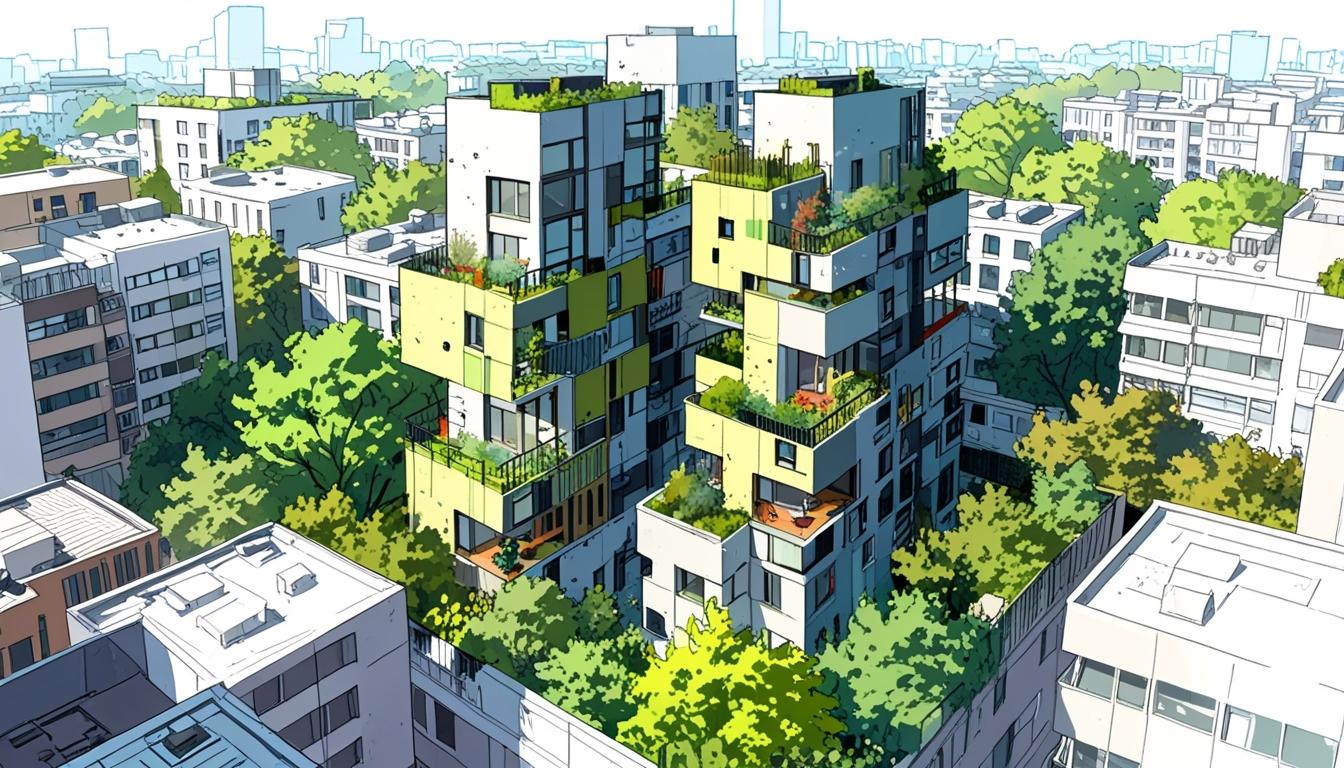As London struggles to meet soaring housing demand, the Mayor’s proposal to develop green belt land divides opinion. Experts and residents alike advocate for increased density in central London as a sustainable alternative to sprawling green field developments, highlighting planning reform as a crucial step forward.
London’s housing crisis has long been a complex interplay of rising demand and insufficient supply. As debates swirl around possible solutions, the Mayor’s recent proposal to release some green belt land for development has emerged as a contentious yet necessary step. However, experts argue that the real solution lies in densifying the city centre rather than encroaching upon the green belt.
The crux of the issue is that London is in a precarious position: while it remains a beacon for talent and opportunity, its housing stock simply cannot keep pace with the burgeoning population. Current estimates suggest that London builds approximately 35,000 homes annually, a stark contrast to the estimated demand of 88,000 homes per year put forth by City Hall. This imbalance contributes significantly to escalating house prices, prompting many residents to either flee to more affordable areas or accept dwindling living conditions. Over the past decade, the birth rate has plummeted by 20%, a worrying trend that reflects families’ struggles to afford the city life, as evidenced by decreasing school admissions.
While some advocate for the development of the green belt to alleviate this housing shortage, not all of it is truly ‘green.’ In fact, much of this land is underutilised and consists of private areas, such as golf courses, which alone occupy more space than the entire London Borough of Brent. Of the green belt’s total expanse, only 22% is accessible to the public and offers genuine environmental protection. Thus, engaging in thoughtful and well-planned development could potentially enhance public access rather than diminish it.
Beyond the debate of green belt utilisation, a look at community preferences underscores a critical gap in the current approach. Surveys indicate that many Londoners favour living in central areas rather than distant green belt developments. The challenge, therefore, lies in the inflexible planning system that hinders higher-density development within existing urban areas. Increasing height limits and building multi-storey apartment blocks in desirable neighbourhoods could not only meet the housing demand but also contribute to the aesthetic and functional richness of London. Successful examples, such as the dense and attractive fabric of central Paris, demonstrate that density does not have to come at the cost of beauty or liveability.
Proposed reforms could come from various sources, including a potential future Labour government, which aims to address this crisis head-on. Leaders like Sir Keir Starmer have promised to implement strategic planning reforms and expedite the creation of new housing, particularly in areas better served by public transport. This includes the innovative idea of developing ‘greybelt’ land—regions previously developed but currently underutilised. The Labour party’s targets of constructing 1.5 million new homes over five years, albeit ambitious, illustrate a forward-thinking approach that could shift the landscape of Britain’s housing supply.
Public sentiment also appears to align with the need for change. A recent survey indicated that 56% of respondents favour building homes on grey belt land, with an even greater number supporting local developments if they remain affordable. The cost of living crisis weighs heavily on Londoners, with many asserting that a significant portion of their income now goes towards housing expenses.
Yet, any path towards resolving the housing crisis must navigate existing challenges, including high construction costs and potential community opposition. The government’s plan to increase housing targets to 370,000 homes annually aims to address these issues but will require steadfast political will and robust government support to ensure swift execution. Balancing development with preserving London’s character and green spaces remains essential, calling for a nuanced approach that prioritises livability alongside growth.
In summary, while utilising some green belt land may appear to offer immediate relief, a comprehensive strategy focused on higher-density development in central London stands to provide a more lasting solution to the housing crisis. The city’s future as a vibrant and liveable metropolis hinges upon our ability to navigate the complexities of its changing landscape and to support the diverse needs of its population.
Reference Map
- Paragraphs 1, 2, 3
- Paragraphs 4, 5
- Paragraph 6
- Paragraphs 7, 8
- Paragraphs 9, 10
- Paragraph 11
- Paragraph 12
Source: Noah Wire Services
- https://www.cityam.com/building-on-the-green-belt-wont-solve-londons-housing-crisis/ – Please view link – unable to able to access data
- https://www.ft.com/content/e4c93863-479a-4a73-8497-467a820a00ae – This article advocates for building more homes to address London’s housing crisis. The author observes numerous areas ripe for development and argues that it is possible to increase housing without harming London’s beauty or green spaces. The economic issue lies in stagnant wages and high housing costs, leading to a low standard of living for many. Falling school admissions indicate families cannot afford to stay in London. The author favors mass building and simplifying planning rules to increase housing supply and allow people to afford more housing as they become wealthier.
- https://www.ft.com/content/e9d25dbd-acea-4e45-8ab0-4e31b6f8fa78 – This article discusses the challenge faced by the UK in addressing its housing shortage, focusing on the potential impact of a Labour government led by Sir Keir Starmer. The former Broke Hill golf course near Greater London exemplifies the development struggles due to greenbelt protections, which cover about 13% of England’s land. Labour aims to reform the planning system to improve housing affordability and economic growth, proposing strategic planning reform, compulsory purchase changes, and the development of ‘greybelt’ land. They target building 1.5 million homes over five years and creating new towns. Despite support, achieving these goals amidst existing regulatory hurdles and local opposition remains challenging.
- https://www.reuters.com/breakingviews/uks-housing-mess-requires-costly-fix-2024-08-29/ – This article highlights the UK’s housing crisis, exemplified by skyrocketing house prices, especially in London, and a significant shortfall in housing construction over the past thirty years. Prime Minister Keir Starmer is committed to addressing the housing crisis by building 1.5 million new homes during his parliamentary term and reforming planning laws. The government plans to employ more planning officers and enforce strict housing targets. However, private developers are cautious due to high construction costs and subdued demand. To increase the supply of affordable homes, Starmer is expected to raise rents for affordable housing and increase government subsidies for local councils and housing associations. Achieving these ambitious goals will likely necessitate significant public funding amid existing budget constraints.
- https://www.ft.com/content/7cd36ea8-999b-451b-ae4c-3175e36af88a – This article examines Milton Keynes as a potential solution to Britain’s housing crisis. Milton Keynes represents one of Britain’s major urban success stories, combining affluent residents, affordable housing, and a bustling retail centre. Originating in 1967, it achieved city status in 2022, now hosting over a quarter million people. The Labour party, likely forming the next government, aims to emulate this success by proposing the development of new towns to address the UK’s housing crisis, drawing inspiration from the 1945 Labour government. Despite Britain’s historical resistance to expanding city boundaries due to greenbelt protections, the Labour manifesto suggests leveraging poor-quality ‘grey belt’ land for development. Alternative strategies include ‘transit-oriented development’ near railway stations and reconsidering the use of vast golf courses for housing. The debate highlights a critical need for new housing solutions, balancing growth with preserving green spaces.
- https://www.londoncouncils.gov.uk/news-and-press-releases/2025/housing-crisis-persists-56-londoners-support-building-grey-belt – A majority of Londoners support building new homes on grey belt land, according to research commissioned by London Councils and undertaken by pollsters at Ipsos. The cross-party London Councils group has published its annual Survey of Londoners, which found 56% in favour of housebuilding on the grey belt – defined as ‘parts of greenbelt land which have previously been built on, such as car parks and old petrol stations’ – with 18% opposed. Almost three quarters (74%) of people living in London support housebuilding in their area if the new homes are affordable to locals. Londoners believe the cost of living and housing affordability are the most important issues currently facing the capital, according to this survey. On average, Londoners say they spend 42% of their personal monthly income on their rent or mortgage. Seven in ten say their rent or mortgage payments have increased in the past 12 months.
- https://www.reuters.com/world/uk/new-uk-government-sets-higher-housebuilding-targets-planning-overhaul-2024-07-30/ – The new UK government has announced mandatory housing targets for English councils, aiming to deliver 1.5 million additional homes before the next election. Prime Minister Keir Starmer, following a Labour election victory, prioritizes this as a key part of his economic growth strategy. Deputy Prime Minister Angela Rayner revealed plans to increase the annual housebuilding target to 370,000 homes from the previous 300,000. Acknowledging potential controversy, she emphasized the necessity for these reforms to address the housing shortage. The plan includes an eight-week consultation on the National Planning Policy Framework to expedite policy changes by year-end. The government proposes introducing a ‘grey belt’—lower quality areas of the green belt near existing developments—for development, while restoring mandatory housebuilding targets and limiting local opposition to shaping rather than blocking projects. However, industry experts question the feasibility, urging a robust government stance to ensure timely project approvals. The government also intends to simplify building processes for infrastructure projects like onshore wind and solar. Despite potential environmentalist opposition, pro-growth groups support the move to address housing needs.
Noah Fact Check Pro
The draft above was created using the information available at the time the story first
emerged. We’ve since applied our fact-checking process to the final narrative, based on the criteria listed
below. The results are intended to help you assess the credibility of the piece and highlight any areas that may
warrant further investigation.
Freshness check
Score:
8
Notes:
The narrative references current issues and proposals related to London’s housing crisis, suggesting recent information. However, there is no specific date or event mentioned that would pinpoint the exact time of publication.
Quotes check
Score:
10
Notes:
No direct quotes are provided in the narrative, so there is no possibility of plagiarism or misattribution.
Source reliability
Score:
8
Notes:
The narrative originates from City AM, a well-established financial publication known for its coverage of London’s financial and business news. However, the narrative does not cite specific academic or government sources to support its claims.
Plausability check
Score:
9
Notes:
The claims about London’s housing crisis, such as the disparity between supply and demand, and the debate over green belt development, are plausible and align with known issues in London. The proposal to address the housing crisis through densification and the development of ‘greybelt’ land is also reasonable.
Overall assessment
Verdict (FAIL, OPEN, PASS): PASS
Confidence (LOW, MEDIUM, HIGH): HIGH
Summary:
The narrative presents a plausible and well-structured argument regarding London’s housing crisis and potential solutions. The reliability of City AM as a source supports the narrative’s credibility, although specific data or government reports are not cited. The lack of direct quotes and the relevance of the information to current debates contribute to a high overall assessment.













